| |
| |
Photographer,
Location |
Images |
Comments |
|

|
Stephen James O'Meara,
Mauna Loa, Hawaii, 7,000 foot level
Jan. 21, 2007 |
#1 |
The synchrones
have faded significantly to the unaided eye, but you can
still see them even with a bright cresent Moon in the comet's
tail.
Photo
details: Canon
20D camera and a 17-mm
lens; ISO 1600, 67 second exposure at f/2.8
|
|
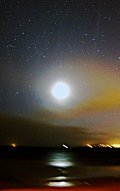
|
Pete Lawrence,
Selsey, West Sussex, UK
Jan. 21, 2007 |
#1,
#2 |
McNaught hangs
on in the northern hemisphere! The Moon is now coming into
view causing problems with its light. However, a long exposure,
stretched to reveal faintness, reveals the ghostly end of
McNaught's tail still faintly visible behind the Moon.
|
|

|
Mila Zinkova,
San Francisco, California, USA
Jan. 20, 2007 |
#1,
more |
I just found
the
famous drawing of the tail of the de Cheseaux's Comet
in 1744: It looks surprisingly similar to the
picture I took on 1/20/07: Of course in my pictures
I've got the Moon and Venus too. The comet's tail looked
as the crown of the Moon. Tonight (1/22/07) I tried to see
the comet's tail again, but I have seen it no more.
Photo
details: Canon
XTI, 18
mm lens, f1.8 ISO 400, 20 seconds exposure
|
|
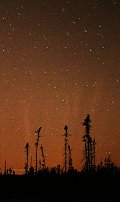
|
Bob
King,
Duluth, Minnesota, USA
Jan. 19, 2007 |
#1,
|
I
heard about additional tail plumes or synchrones in Comet
McNaught becoming visible for northern hemisphere viewers
after dusk so I went out hoping to see them for myself.
Despite very clear skies, the streamers were faint and mingled
with the zodiacal light. 10x50 binoculars were a big help
however and made them so much easier to see. I counted six
in all. Knowing how far below the horizon the comet was
at the time, I was truly impressed with the vast extent
with which McNaught has spread its dust within the inner
solar system. Enif in Pegasus is at far right. The photo
was taken at 7 p.m. ( approx. two hours after sunset) with
a 30 second exposure, 35mm lens and ISO 800. |
|
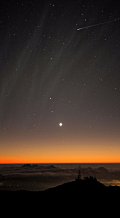
|
Rob
Ratkowski,
Haleakala High Altitude Observatory
Jan. 19, 2007 |
#1,
more |
Another
attempt at capturing the tail of McNaught but this time
from 10 thousand feet. the tail was quite visible in the
Zodiacal Light and a group of good images were acquired
and another image with a meteor--the 2nd in 2 nights. I
love this photo, just a bit fantastic but ever so real.
Photo
details: Nikon
D200, 35mm
lens @ F2, 2 minutes, 200 ISO, guided |
|
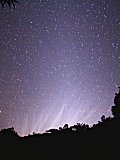
|
Stephen
James O'Meara,
The 7,000 foot level of Mauna Loa Volcano on the Big Island
of Hawaii
Jan. 19, 2007 |
#1,
#2 |
This
photograph shows the synchrons of Comet MacNaught's dust
tail as seen from the 7,000 foot level of Mauna Loa in Hawaii.
Photo
details: Canon
20D camera, 17mm
lens, ISO 1600, 46 sec expsore at f/3.5. |
|
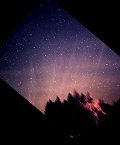
|
Richard Nolthenius,
Bonny Doon, Californnia, USA
Jan. 20, 2007 |
#1,
#2, more |
The tail streamers reminded me of a ghostly forest of tree trunks, here silhouetted by giant redwoods in the mountains above Santa Cruz. Incredible - these columns are shooting northward almost one full wide-angle lens field of view per night! They are actually heading towards us, accounting for their amazing angular speed. first: 7:03pm PST, 3 minutes w/ ST2000XCM CCD camera and 24mm f/2.8 lens. Second photo is 44 seconds on a tripod just after moonset at 7:25pm
|
|

|
Vincent
Jacques,
Authion mount (2000m alt.) near Menton, SE of FRANCE
Jan. 20, 2007 |
#1,
#2, #3,
#4, more |
3 beams were
easily visible with naked eye, zodiacal light was also visible
up to 60°.
Photo
details: Canon
EOS 350D, 18-50mm lens
|
|

|
Jimmy
Westlake,
Stagecoach, Colorado, USA
Jan. 19, 2007 |
#1,
more |
Words
can't adequately describe what was visible in the western
sky after sunset tonight. The dusty wisps of Comet McNaught's
tail filled the sky like auroral streamers, easily visible
to the unaided eye. I said goodbye to the comet last Saturday
after seeing it with the unaided eye in the daytime. Tonight,
I feel like I was visited by the ghost the comet! I am still
speechless.
Photo
details: 30 second guided exposure with a Fuji
Finepix S2 digital camera set at ISO 800. I used a 35mm
wide angle lens at f/3.3. Time of the photo was 6:37:35
pm MST. |
|
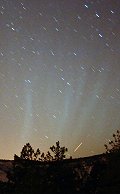
|
Darrell
Spangler,
Drake, Colorado
Jan. 19, 2007 |
#1,
#2, #3 |
About
an hour after sunset, the tail of Comet McNaught became
clearly visible over Rocky Mountain National Park. An awesome
sight indeed! Canon
EOS 300D, 15-30sec, f/1.8-f/4, 400-1600 ISO. |
|
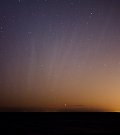
|
Chris Cook,
Cape Cod, Massachusetts, USA
Jan. 19, 2007 |
#1,
more |
These images
show multiple synchronic bands from Comet McNaught!! Amazing!
These were taken from 42°N overlooking the Atlantic Ocean.
They were faintly visible without optical aid and looked
like a very faint aurora.
Photo
details: Canon
5D, 24-70mm f/2.8L lens, ISO 500 or 800, 30 sec or 60
sec exposure.
|
|
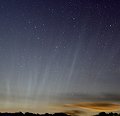
|
Marco
Fulle,
Avaglio (UD, Italy) 750m.a.s.l.
Jan. 19, 2007 |
#1,
more |
Note the faint striae at extreme right, making this the
longest dust tail ever.
Photo
details: Fuji
S3 @ 800ISO f=35mm f/1.4 @ f/2 stack of 4 exposures
2 minutes each field of the image 22 x 33 degrees. |
|
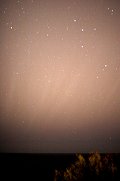
|
Derek
Wallentinsen,
Photo taken at Pt. Vicente, California (inside Los Angeles
megalopolis).
Jan. 19, 2007 |
#1,
|
With
the naked eye, the tail looked like the zodiacal light -
no streamers, just a broad band about 15 degrees high and
maybe 25 wide. I took this and other pictures and could
see the bands immediately after the camera finished processing
them in the post viewer. Amazing! Synchronic bands and very
reminiscent of Comet West thirty years ago. This comet is
comparable and after this observation is probably No. 4
on my lifetime cometary spectacle list after Hale-Bopp,
West and Bennett.
Photo
details: 708PM PST, 50mm
lens at f/1.8, 10 seconds, ISO 800, Canon
20D. Note the Water Jar in Aquarius at top. |
|
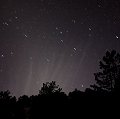
|
Chris
Peterson,
Guffey, Colorado
Jan. 19, 2007 |
#1,
more |
The
comet tail extended to an altitude of 30° 90 minutes after
sunset. Visually, it appeared as a colorless aurora.
Photo
details: 120s exposure, Canon
300D, 18mm FL, f/3.5, ISO 400. |
more
images: from Douglas
Slauson of Norway, Iowa (Jan. 19); from
Elias Chasiotis on Panion mountain outside of Athens, Greece
(Jan. 20); from Tony Tanti
of Dingli, Malta (Jan. 20). |
|